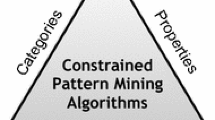Abstract
Frequent itemset mining aims at discovering patterns the supports of which are beyond a given threshold. In many applications, including network event management systems, which motivated this work, patterns are composed of items each described by a subset of attributes of a relational table. As it involves an exponential mining space, the efficient implementation of user preferences and mining constraints becomes the first priority for a mining algorithm. User preferences and mining constraints are often expressed using patterns’ attribute structures. Unlike traditional methods that mine all frequent patterns indiscriminately, we regard frequent itemset mining as a two-step process: the mining of the pattern structures and the mining of patterns within each pattern structure. In this paper, we present a novel architecture that uses pattern structures to organize the mining space. In comparison with the previous techniques, the advantage of our approach is two-fold: (i) by exploiting the interrelationships among pattern structures, execution times for mining can be reduced significantly; and (ii) more importantly, it enables us to incorporate high-level simple user preferences and mining constraints into the mining process efficiently. These advantages are demonstrated by our experiments using both synthetic and real-life datasets.
Similar content being viewed by others
References
Agrawal R, Imielinski T, Swami A (1993) Mining association rules between sets of items in large databases. In: VLDB, pp 207–216
Agrawal R, Srikant R (1994) Fast algorithms for mining association rules. In: VLDB, pp 487–499
Agrawal R, Srikant R (1995) Mining sequential patterns. In: ICDE, pp 3–14
Chaudhuri S (1998) Data mining and database systems: where is the intersection? In: Bulletin of the IEEE computer society technical committee on data engineering 21(1):4–8
Fu Y, Han J (1995) Meta-rule-guided mining of association rules in relational databases. In: Proceedings of the 1st international workshop on integration of knowledge discovery with deductive and object-oriented databases (KDOOD’95), Singapore, pp 39–46
Grahne G, Lakshmanan LV, Wang X, Xie MH (2001) On dual mining: From patterns to circumstances, and back. In: ICDE, pp 195–204
Han J, Fu Y (1995) Discovery of multiple-level association rules from large databases. In: VLDB, pp 420–431
Hellerstein J, Ma S, Perng CS (2002) Discovering actionable patterns in event data. IBM Syst J 41:475–493
Kamber M, Han J, Chiang JY (1997) Metarule-guided mining of multi-dimensional association rules using data cubes. In: SIGKDD, pp 207–210
Ng R, Lakshmanan L, Han J, Pang A (1998) Exploratory mining and pruning optimizations of constrained associations rules. In: SIGMOD, pp 13–24
Perng C-S, Wang H, Ma S, Hellerstein JL (2001) A framework for exploring mining spaces with multiple attributes. In: ICDM, pp 449–456
Shen W, Ong K, Zaniolo BM, Zaniolo C (1996) Metaqueries for data mining. AAAI/MIT Press, pp 375–398
Srikant R, Agrawal R (1995) Mining generalized association rules. In: VLDB, pp 407–419
Srikant R, Agrawal R (1996) Mining sequential patterns: Generalization and performance improvements. In: EDBT, pp 3–17
Srikant R, Vu Q, Agrawal R (1997) Mining association rules with item constraints. In: SIGKDD, pp 67–93
Wang H, Perng C-S, Ma S, Yu PS (2002) Mining associations by pattern structure in large relational tables. In: ICDM, Maebashi City, Japan, pp 482–489
Author information
Authors and Affiliations
Corresponding author
Rights and permissions
About this article
Cite this article
Wang, H., Perng, CS., Ma, S. et al. Demand-driven frequent itemset mining using pattern structures. Knowl Inf Syst 8, 82–102 (2005). https://doi.org/10.1007/s10115-004-0170-9
Received:
Revised:
Accepted:
Published:
Issue Date:
DOI: https://doi.org/10.1007/s10115-004-0170-9




